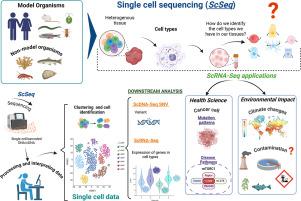Single-cell RNA sequencing offers opportunities to explore the depth of physiology, adaptation, and biochemistry in non-model organisms exposed to pollution
IF 4.6
Q2 MATERIALS SCIENCE, BIOMATERIALS
引用次数: 0
Abstract
Single-cell Sequencing technology (scSeq) has revolutionized our understanding of individual cells, uncovering unprecedented heterogeneity within tissues and cell populations, principality through single-cell RNA Sequencing (scRNA-Seq). This short review highlights the pivotal role of scRNA-Seq in elucidating genotype-phenotype relationships, particularly in biological systems. Based on published articles, our analysis involved manual curation and automated Scopus tools to illustrate recent advances in the application of scRNA-Seq. The results reveal that scRNA-Seq has been extensively utilized in various biological areas, including biochemistry, genetics, molecular biology, immunology, and microbiology, followed by health sciences covering studies related to the nervous system, immune system, human health, development, and diseases, with a particular focus on cancer research. However, the potential of scRNA-Seq extends beyond disease research, offering insights into non-model organisms' responses to environmental contaminants. By enabling the study of cellular reactions at a molecular level, scRNA-Seq provides a comprehensive understanding of intracellular heterogeneity that enhances our comprehension of physiological, biochemical, and pathological environmental impacts on non-model organisms exposed to pollution. This understanding has many practical benefits, as it can aid in regulation and conservation efforts that benefit the environment and the use of economically essential and ecologically relevant organisms.

单细胞 RNA 测序为探索暴露于污染的非模式生物的生理、适应和生化深度提供了机会。
单细胞测序技术(scSeq)彻底改变了我们对单个细胞的认识,通过单细胞 RNA 测序(scRNA-Seq)发现了组织和细胞群内前所未有的异质性。这篇简短的综述强调了 scRNA-Seq 在阐明基因型与表型关系方面的关键作用,尤其是在生物系统中。我们的分析以已发表的文章为基础,采用人工编辑和自动 Scopus 工具来说明 scRNA-Seq 应用的最新进展。结果显示,scRNA-Seq 已被广泛应用于各个生物学领域,包括生物化学、遗传学、分子生物学、免疫学和微生物学,其次是健康科学,涵盖与神经系统、免疫系统、人体健康、发育和疾病有关的研究,尤其侧重于癌症研究。然而,scRNA-Seq 的潜力并不局限于疾病研究,它还能深入了解非模式生物对环境污染物的反应。通过在分子水平上研究细胞反应,scRNA-Seq 提供了对细胞内异质性的全面了解,从而提高了我们对暴露于污染的非模式生物的生理、生化和病理环境影响的理解。这种理解有很多实际好处,因为它有助于有利于环境的调节和保护工作,以及对经济上重要的生态相关生物的利用。
本文章由计算机程序翻译,如有差异,请以英文原文为准。
求助全文
约1分钟内获得全文
求助全文

 求助内容:
求助内容: 应助结果提醒方式:
应助结果提醒方式:


